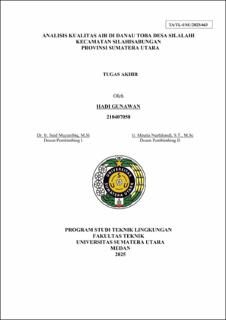| dc.description.abstract | Lake Toba is a large natural lake in North Sumatra, located in North Sumatra Province, Indonesia.The
presence of activities such as power generation, fish farming, tourism, and domestic use can affect the
Lake Toba ecosystem, thereby impacting the lake's water quality.The objective of this research is to
determine the water quality of Lake Toba based on physical, chemical, and biological parameters using
the STORET and NSF WQI methods with 4 sampling stations (hydroelectric power plant area, hotels &
restaurants, residential areas, and free beach areas) selected through Purposive Random Sampling, as
well as to understand the influence of activities and seasons on parameter values using One Way
ANOVA statistical analysis. The research results show that the phosphate parameter values, both in the
rainy and dry seasons, exceed the quality standards at all stations, with reference to Class I quality
standards according to Government Regulation No. 22 of 2021.During the dry season sampling, the
TSS parameter value exceeded the quality standard at station III, and the BOD parameter value
exceeded the quality standard at stations I and III. According to the results of the STORET method
calculations, Lake Toba falls under the "Slightly Polluted" category at stations II and IV and the
"Moderately Polluted" category at stations I and III concerning Class I quality standards. In the
NSF WQI method, the status is "Good" at all stations.Based on the statistical analysis results, the values
of each parameter by station location do not show significant changes. However, based on sampling in
different seasons, the values of turbidity and pH parameters show significant changes. Overall, the
research results indicate that the differences in water quality assessment methods (STORET and
NSF-WQI) yield different outcomes regarding the status of water quality. This suggests that the
interpretation of water quality is highly influenced by the method used, thus the selection of the
appropriate method needs to be aligned with the objectives of water quality evaluation. | en_US |


